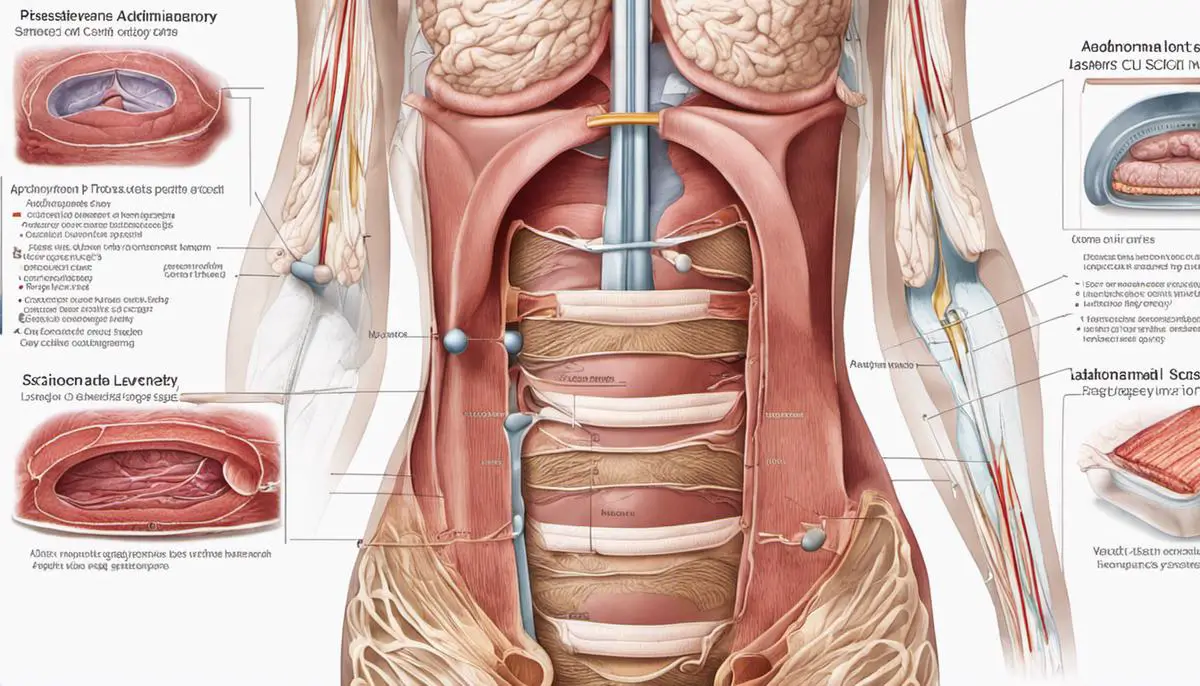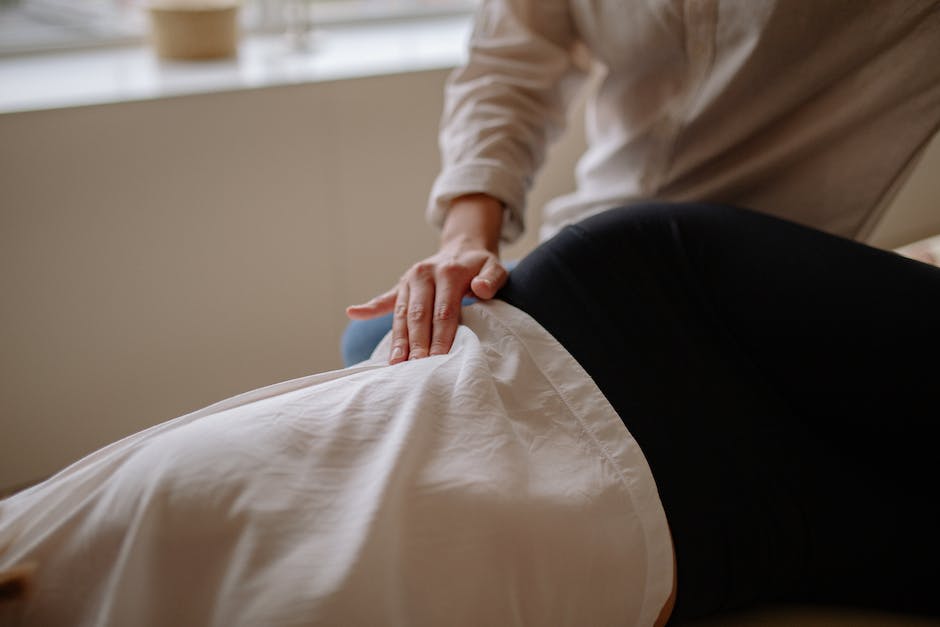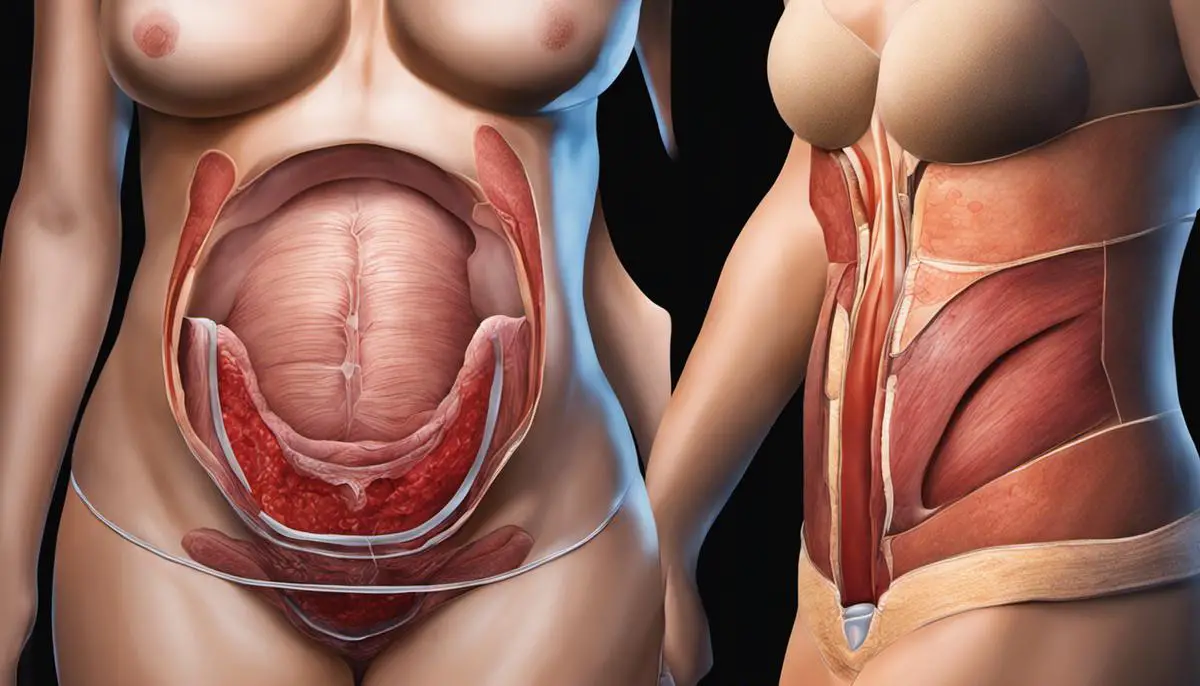The recovery journey after a C-section is an intricate process that requires knowledge and understanding of the body’s healing mechanisms, especially concerning the abdominal area. Navigating through this transition can greatly benefit from the incorporation of safe and therapeutic belly massages once approval is given by a healthcare professional. Firmly rooted in the understanding of post-surgery wound healing and scar tissue formation, the right massage techniques can accelerate the body’s natural recovery process. However, several precautions must also be duly recognized to prevent complications or discomfort. This comprehensive guide aims to provide a more informed perspective on the beneficial practice of belly massage post C-section, highlighting its proper techniques, necessary precautions, and the importance of professional consultation.
Anatomy and Healing Post C-Section
Understanding Abdominal Anatomy Post C-Section
A c-section, or cesarean section, is a surgical method for delivering a baby. This procedure involves making a cut through a woman’s abdomen and uterus. Post c-section, your abdominal area has undergone significant changes. The muscles, nerves, and tissues in and around the area have been disrupted and need time to heal.
When considering the anatomy of the abdominal area, it’s important to recognize the various layers impacted by a c-section. From outside-in, these include the skin, fat tissue, rectus abdominis muscles, and finally the uterus.
Wound Healing Post C-Section
The body initiates the healing process immediately after injury or surgical procedures like a c-section. Wound healing occurs in four overlapping stages: hemostasis (when the bleeding stops), inflammation, proliferation, and remodeling.
Hemostasis begins immediately after the cut is made during a c-section. The body works to stop the bleeding by clotting the blood. After this, inflammation sets in, which might result in swelling and pain. This is your body’s way of protecting the wound and destroying any bacteria.
The third stage is proliferation, when the wound is actually ‘rebuilt’. New tissues are formed to replace the injured tissues. Finally, during the remodeling stage, the new tissue slowly gains strength and flexibility. It is during this stage that a scar forms.
Scar Tissue Formation
Scar tissue formation is a crucial part of the healing process after a c-section. Once a wound has closed, the body forms a scar by producing a protein called collagen to ‘seal’ the wound area. This new tissue will not exactly resemble the tissue it replaces, but rather it is a fibrous tissue which is strong and helps to prevent further injury.
However, scar tissue may potentially bind down to underlying structures, causing adhesions, and leading to pain or discomfort.
Body’s Natural Recovery Process
The body’s natural recovery process kicks in immediately after a c-section. The average healing time post c-section is six weeks, but this can vary from person to person depending on overall health, age, and the presence of complications.
During this period, it’s advised to avoid heavy lifting and increase physical activity slowly and gradually. Listen to your body: rest when you are tired and seek assistance when needed. Proper nourishment and hydration also accelerate the healing process.
Belly Massage and Healing
Belly massage, particularly around the scar, can aid in the healing process. It helps to break down scar tissue, reduce adhesions, and increase blood flow to the area which further aids in healing. Gentle massages can usually start about six to eight weeks post-surgery or once the wound has completely healed.
Using gentle, circular motions around the scar can help, though direct pressure over the scar should be avoided initially. Remember to consult with your doctor before beginning abdominal massages after a c-section to ensure it’s safe for you.

Safe Massage Techniques after C-Section
Understanding the Importance of Post C-Surgery Massage
Massage after a C-section can aid in healing and recovery, reduce scar tissue buildup, improve circulation, and potentially lessen post-surgical pain. When done correctly, it can enhance your overall well-being and speed up the healing process.
When to Start Massaging After a C-section
Typically, the recommendation is to start massaging the area approximately two weeks post-surgery, once the incision has primarily closed and is no longer raw or sensitive. You must, however, consult with your doctor for a precise timeline based on your own individual healing process. Above all else, listen to your body and refrain from any activity that causes discomfort or pain.
Techniques for Post C-Section Massage
One of the simplest techniques involves gentle rubbing movements. Use the index and middle fingers to gently rub in a circular motion around the scar, not directly on it. This improves blood flow to the area, promoting healing and reducing the buildup of scar tissue.
As your scar starts to heal and the pain subsides, you can gradually apply more pressure and even start massaging directly on the scar. The goal is to discourage the development of adhesions, which are bands of scar tissue that can potentially cause discomfort and limit mobility.
Points to Remember During the Massage
Always maintain a gentle, consistent pressure. You need to be cautious about not causing further distress to the healing incision. If you feel pain at any time during the massage, stop immediately.
It’s also essential to keep the incision clean before and after the massage. Warm, soapy water will suffice for this purpose.
Incorporating Essential Oils
Certain essential oils may aid in healing and relaxation. For instance, lavender oil can promote wound healing and has a soothing, calming effect. Frankincense oil may also be beneficial due to its anti-inflammatory properties. Remember to always dilute essential oils properly in a carrier oil, like olive or coconut oil, before applying it to the skin to avoid irritation.
In conclusion, post c-section massage can be beneficial for healing and recovery. However, it should always be done with care and caution, keeping in mind individual healing timelines and possible sensitivities. It’s always prudent to consult with healthcare professionals before beginning any new treatment regimen.

Precautions and Contraindications
Understanding Belly Massage after C-Section
Belly massage following a cesarean section, or C-section, can support healing by stimulating circulation, easing discomfort, and enhancing body awareness. However, several factors can combine to make this practice potentially harmful. Recognizing these situations and avoiding belly massage in these circumstances increases the likelihood of an effective and complication-free recovery.
Contraindications
- Signs of infection: These could manifest as fever, warmth, redness, or swelling around the incision area. If you notice any unusual discharge or smell from the incision site, this could also indicate an infection. In these circumstances, it’s best to avoid massaging the area, as this could potentially worsen the infection or spread it.
- Extended or abnormal bleeding: Both minor leakage and heavy bleeding are red flags. Any non-standard bleeding around the surgery area is a concerning symptom that would render belly massages counterproductive and possibly harmful.
- Intense or prolonged pain: It’s normal to experience some discomfort or mild pain following a C-section, but any intense or persistent pain is a warning sign. Belly massages should be avoided in these cases, as they could exacerbate the pain, particularly if underlying complications are causing the discomfort.
Considering Timing
The timing of belly massages after surgical procedures is crucial. Direct massaging of the incision area should be avoided for at least six weeks after the surgery or until your doctor clears you for it. Performing a massage too soon can interrupt the healing process, leading to complications.
Who Should Perform The Massage
It’s also important to note that any post-surgical massage, including belly massage post C-section, should be performed by qualified professionals. They are aware of the risks, can recognize signs of potential complications, and understand how to adjust the massage to prevent causing harm.
Detection
Continuous monitoring of your physical wellbeing is paramount; you should communicate any symptoms to your healthcare provider promptly. They can guide you on when it is safe to return to activities like belly massaging, depending on your individual healing progression and any complications that may arise.

Consultation With Health Professionals
Importance of Professional Consultation
In the stages following a C-section surgery, it’s paramount to consult with health professionals before starting a belly massage regimen. There’s no ‘one-size-fits-all’ method for post C-section care, as each individual will experience different levels of healing time and pain relief.
Discuss Concerns About Belly Massage
Health professional primarily being your physician or a physical therapist can provide advice based on your body’s specific needs and healing process. Bring up any worries or anxieties you may have about starting a belly massage routine. The professionals can elucidate any misconceptions and give you a better understanding of the do’s and don’ts related to belly massages post c section. This can include advice on the right amount of pressure to apply, the best techniques to use, and the optimal time to start massaging after your surgery.
Share Surgical and Healing Details
Share the details of your C-section surgery and postoperative healing process with the health specialist. Information like the type of incision, suturing method used, any complications during or after the surgery, progress in healing, and tenderness or nerve sensitivity around the scar area can play pivotal roles in determining the suitability and safety of belly massages. The professional can accordingly adjust your massage regimen, ensuring that it does not interfere with your healing process or inflict unnecessary pain or discomfort.
Planning Your Massage Regimen
Once you have discussed your concerns and shared your recovery progress, the health professional will assist in devising a massage plan that is both safe and comfortable for you. This plan may include different kinds of massages that focus on promoting scar tissue health, reducing inflammation and promoting blood flow to the area. This could further entail use of certain essential oils, best massage positions, frequency of massages, and a schedule that fits into your overall postpartum recovery.
In case any complications or unusual symptoms arise during the massage regimen, health professionals will guide you regarding modifications or cessation of the massage routine. It’s always helpful to have your progress monitored by a professional who understands your unique health profile and recovery journey.

Optimizing the healing process after a C-section calls for an integrative focus on the body’s resiliency and the supportive role of belly massage. However, recognizing and respecting the body’s signals is crucial in ensuring safe and effective practices. It’s vital to understand when the practice should be avoided due to potential complications like infection or abnormal pain. Prioritizing the consultation with healthcare professionals helps frame a personalized and effective massage regimen, thus giving room for a dialogue about concerns and specific healing details. Remember, belly massages can be instrumental in post C-section healing and recovery, but they must be approached with caution, understanding, and the guidance of experts.
